Taesup Moon
DoMIX: An Efficient Framework for Exploiting Domain Knowledge in Fine-Tuning
Jul 03, 2025Abstract:Domain-Adaptive Pre-training (DAP) has recently gained attention for its effectiveness in fine-tuning pre-trained models. Building on this, continual DAP has been explored to develop pre-trained models capable of incrementally incorporating different domain datasets. However, existing continual DAP methods face several limitations: (1) high computational cost and GPU memory usage during training; (2) sensitivity to incremental data order; and (3) providing a single, generalized model for all end tasks, which contradicts the essence of DAP. In this paper, we propose DoMIX, a novel approach that addresses these challenges by leveraging LoRA modules, a representative parameter-efficient fine-tuning (PEFT) method. Our approach enables efficient and parallel domain-adaptive pre-training that is robust to domain order and effectively utilizes accumulated knowledge to provide tailored pre-trained models for specific tasks. We also demonstrate that our method can be extended beyond the DAP setting to standard LLM fine-tuning scenarios. Code is available at https://github.com/dohoonkim-ai/DoMIX.
Multi-Group Proportional Representation for Text-to-Image Models
May 29, 2025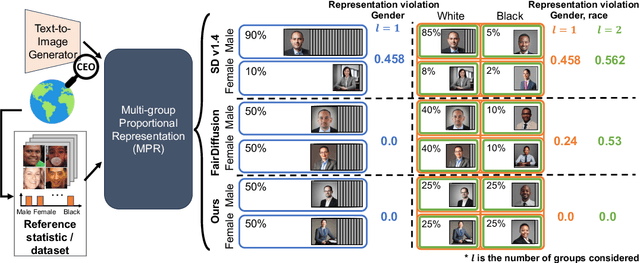
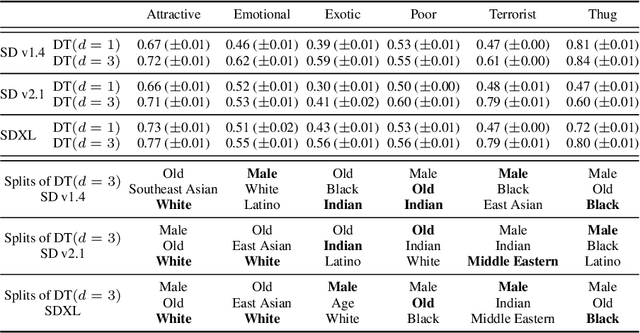
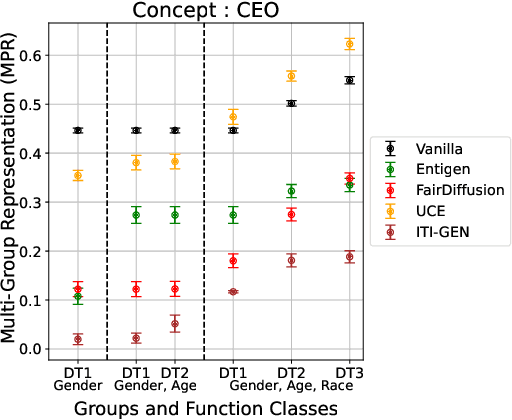
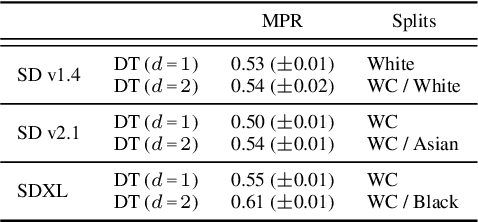
Abstract:Text-to-image (T2I) generative models can create vivid, realistic images from textual descriptions. As these models proliferate, they expose new concerns about their ability to represent diverse demographic groups, propagate stereotypes, and efface minority populations. Despite growing attention to the "safe" and "responsible" design of artificial intelligence (AI), there is no established methodology to systematically measure and control representational harms in image generation. This paper introduces a novel framework to measure the representation of intersectional groups in images generated by T2I models by applying the Multi-Group Proportional Representation (MPR) metric. MPR evaluates the worst-case deviation of representation statistics across given population groups in images produced by a generative model, allowing for flexible and context-specific measurements based on user requirements. We also develop an algorithm to optimize T2I models for this metric. Through experiments, we demonstrate that MPR can effectively measure representation statistics across multiple intersectional groups and, when used as a training objective, can guide models toward a more balanced generation across demographic groups while maintaining generation quality.
Option-aware Temporally Abstracted Value for Offline Goal-Conditioned Reinforcement Learning
May 19, 2025Abstract:Offline goal-conditioned reinforcement learning (GCRL) offers a practical learning paradigm where goal-reaching policies are trained from abundant unlabeled (reward-free) datasets without additional environment interaction. However, offline GCRL still struggles with long-horizon tasks, even with recent advances that employ hierarchical policy structures, such as HIQL. By identifying the root cause of this challenge, we observe the following insights: First, performance bottlenecks mainly stem from the high-level policy's inability to generate appropriate subgoals. Second, when learning the high-level policy in the long-horizon regime, the sign of the advantage signal frequently becomes incorrect. Thus, we argue that improving the value function to produce a clear advantage signal for learning the high-level policy is essential. In this paper, we propose a simple yet effective solution: Option-aware Temporally Abstracted value learning, dubbed OTA, which incorporates temporal abstraction into the temporal-difference learning process. By modifying the value update to be option-aware, the proposed learning scheme contracts the effective horizon length, enabling better advantage estimates even in long-horizon regimes. We experimentally show that the high-level policy extracted using the OTA value function achieves strong performance on complex tasks from OGBench, a recently proposed offline GCRL benchmark, including maze navigation and visual robotic manipulation environments.
SEED: Towards More Accurate Semantic Evaluation for Visual Brain Decoding
Mar 09, 2025Abstract:We present SEED (\textbf{Se}mantic \textbf{E}valuation for Visual Brain \textbf{D}ecoding), a novel metric for evaluating the semantic decoding performance of visual brain decoding models. It integrates three complementary metrics, each capturing a different aspect of semantic similarity between images. Using carefully crowd-sourced human judgment data, we demonstrate that SEED achieves the highest alignment with human evaluations, outperforming other widely used metrics. Through the evaluation of existing visual brain decoding models, we further reveal that crucial information is often lost in translation, even in state-of-the-art models that achieve near-perfect scores on existing metrics. To facilitate further research, we open-source the human judgment data, encouraging the development of more advanced evaluation methods for brain decoding models. Additionally, we propose a novel loss function designed to enhance semantic decoding performance by leveraging the order of pairwise cosine similarity in CLIP image embeddings. This loss function is compatible with various existing methods and has been shown to consistently improve their semantic decoding performances when used for training, with respect to both existing metrics and SEED.
Cost-Efficient Continual Learning with Sufficient Exemplar Memory
Feb 11, 2025Abstract:Continual learning (CL) research typically assumes highly constrained exemplar memory resources. However, in many real-world scenarios-especially in the era of large foundation models-memory is abundant, while GPU computational costs are the primary bottleneck. In this work, we investigate CL in a novel setting where exemplar memory is ample (i.e., sufficient exemplar memory). Unlike prior methods designed for strict exemplar memory constraints, we propose a simple yet effective approach that directly operates in the model's weight space through a combination of weight resetting and averaging techniques. Our method achieves state-of-the-art performance while reducing the computational cost to a quarter or third of existing methods. These findings challenge conventional CL assumptions and provide a practical baseline for computationally efficient CL applications.
DEAL: Decoupled Classifier with Adaptive Linear Modulation for Group Robust Early Diagnosis of MCI to AD Conversion
Nov 25, 2024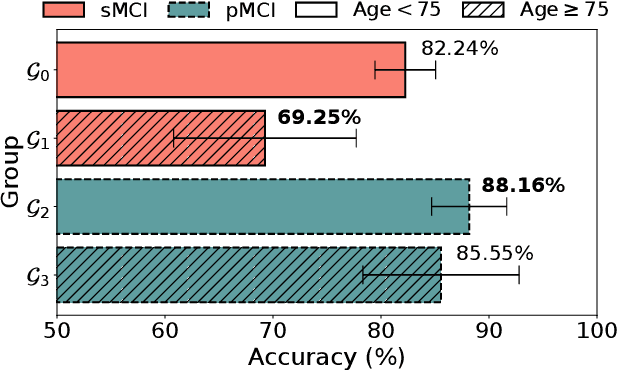


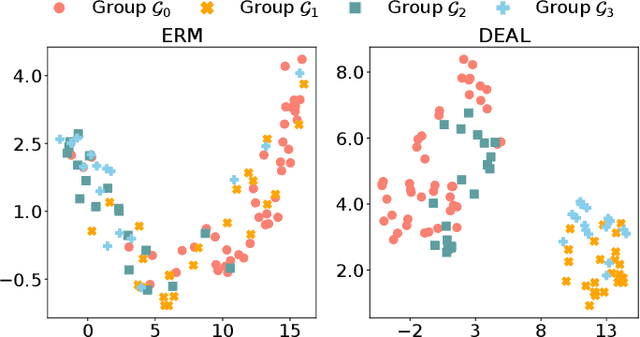
Abstract:While deep learning-based Alzheimer's disease (AD) diagnosis has recently made significant advancements, particularly in predicting the conversion of mild cognitive impairment (MCI) to AD based on MRI images, there remains a critical gap in research regarding the group robustness of the diagnosis. Although numerous studies pointed out that deep learning-based classifiers may exhibit poor performance in certain groups by relying on unimportant attributes, this issue has been largely overlooked in the early diagnosis of MCI to AD conversion. In this paper, we present the first comprehensive investigation of the group robustness in the early diagnosis of MCI to AD conversion using MRI images, focusing on disparities in accuracy between groups, specifically sMCI and pMCI individuals divided by age. Our experiments reveal that standard classifiers consistently underperform for certain groups across different architectures, highlighting the need for more tailored approaches. To address this, we propose a novel method, dubbed DEAL (DEcoupled classifier with Adaptive Linear modulation), comprising two key components: (1) a linear modulation of features from the penultimate layer, incorporating easily obtainable age and cognitive indicative tabular features, and (2) a decoupled classifier that provides more tailored decision boundaries for each group, further improving performance. Through extensive experiments and evaluations across different architectures, we demonstrate the efficacy of DEAL in improving the group robustness of the MCI to AD conversion prediction.
Listwise Reward Estimation for Offline Preference-based Reinforcement Learning
Aug 08, 2024

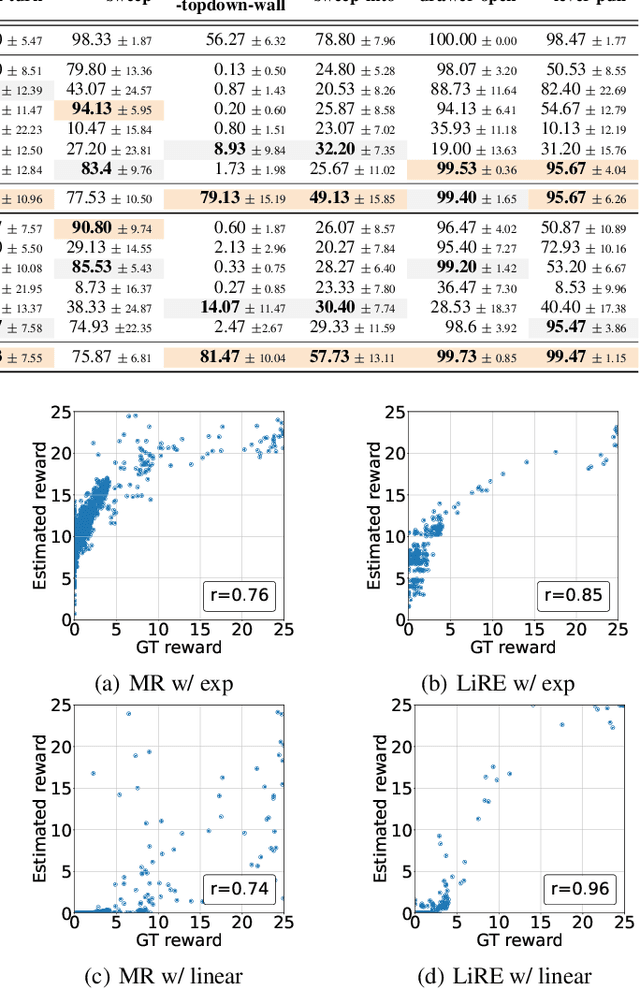

Abstract:In Reinforcement Learning (RL), designing precise reward functions remains to be a challenge, particularly when aligning with human intent. Preference-based RL (PbRL) was introduced to address this problem by learning reward models from human feedback. However, existing PbRL methods have limitations as they often overlook the second-order preference that indicates the relative strength of preference. In this paper, we propose Listwise Reward Estimation (LiRE), a novel approach for offline PbRL that leverages second-order preference information by constructing a Ranked List of Trajectories (RLT), which can be efficiently built by using the same ternary feedback type as traditional methods. To validate the effectiveness of LiRE, we propose a new offline PbRL dataset that objectively reflects the effect of the estimated rewards. Our extensive experiments on the dataset demonstrate the superiority of LiRE, i.e., outperforming state-of-the-art baselines even with modest feedback budgets and enjoying robustness with respect to the number of feedbacks and feedback noise. Our code is available at https://github.com/chwoong/LiRE
Reducing Task Discrepancy of Text Encoders for Zero-Shot Composed Image Retrieval
Jun 13, 2024Abstract:Composed Image Retrieval (CIR) aims to retrieve a target image based on a reference image and conditioning text, enabling controllable searches. Due to the expensive dataset construction cost for CIR triplets, a zero-shot (ZS) CIR setting has been actively studied to eliminate the need for human-collected triplet datasets. The mainstream of ZS-CIR employs an efficient projection module that projects a CLIP image embedding to the CLIP text token embedding space, while fixing the CLIP encoders. Using the projected image embedding, these methods generate image-text composed features by using the pre-trained text encoder. However, their CLIP image and text encoders suffer from the task discrepancy between the pre-training task (text $\leftrightarrow$ image) and the target CIR task (image + text $\leftrightarrow$ image). Conceptually, we need expensive triplet samples to reduce the discrepancy, but we use cheap text triplets instead and update the text encoder. To that end, we introduce the Reducing Task Discrepancy of text encoders for Composed Image Retrieval (RTD), a plug-and-play training scheme for the text encoder that enhances its capability using a novel target-anchored text contrastive learning. We also propose two additional techniques to improve the proposed learning scheme: a hard negatives-based refined batch sampling strategy and a sophisticated concatenation scheme. Integrating RTD into the state-of-the-art projection-based ZS-CIR methods significantly improves performance across various datasets and backbones, demonstrating its efficiency and generalizability.
Towards Realistic Incremental Scenario in Class Incremental Semantic Segmentation
May 16, 2024



Abstract:This paper addresses the unrealistic aspect of the commonly adopted Continuous Incremental Semantic Segmentation (CISS) scenario, termed overlapped. We point out that overlapped allows the same image to reappear in future tasks with different pixel labels, which is far from practical incremental learning scenarios. Moreover, we identified that this flawed scenario may lead to biased results for two commonly used techniques in CISS, pseudo-labeling and exemplar memory, resulting in unintended advantages or disadvantages for certain techniques. To mitigate this, a practical scenario called partitioned is proposed, in which the dataset is first divided into distinct subsets representing each class, and then the subsets are assigned to each corresponding task. This efficiently addresses the issue above while meeting the requirement of CISS scenario, such as capturing the background shifts. Furthermore, we identify and address the code implementation issues related to retrieving data from the exemplar memory, which was ignored in previous works. Lastly, we introduce a simple yet competitive memory-based baseline, MiB-AugM, that handles background shifts of current tasks in the exemplar memory. This baseline achieves state-of-the-art results across multiple tasks involving learning numerous new classes.
Reset & Distill: A Recipe for Overcoming Negative Transfer in Continual Reinforcement Learning
Mar 08, 2024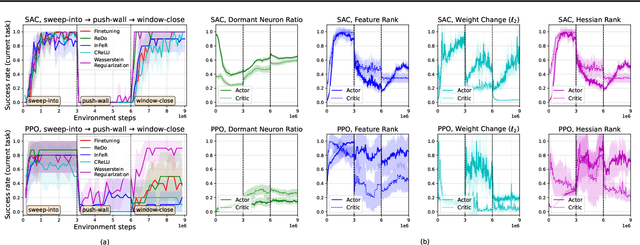

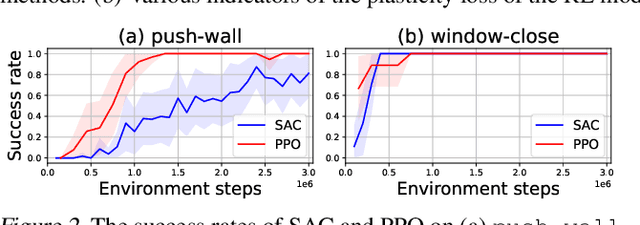
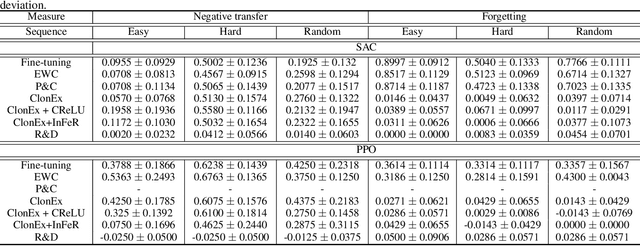
Abstract:We argue that one of the main obstacles for developing effective Continual Reinforcement Learning (CRL) algorithms is the negative transfer issue occurring when the new task to learn arrives. Through comprehensive experimental validation, we demonstrate that such issue frequently exists in CRL and cannot be effectively addressed by several recent work on mitigating plasticity loss of RL agents. To that end, we develop Reset & Distill (R&D), a simple yet highly effective method, to overcome the negative transfer problem in CRL. R&D combines a strategy of resetting the agent's online actor and critic networks to learn a new task and an offline learning step for distilling the knowledge from the online actor and previous expert's action probabilities. We carried out extensive experiments on long sequence of Meta-World tasks and show that our method consistently outperforms recent baselines, achieving significantly higher success rates across a range of tasks. Our findings highlight the importance of considering negative transfer in CRL and emphasize the need for robust strategies like R&D to mitigate its detrimental effects.
 Add to Chrome
Add to Chrome Add to Firefox
Add to Firefox Add to Edge
Add to Edge